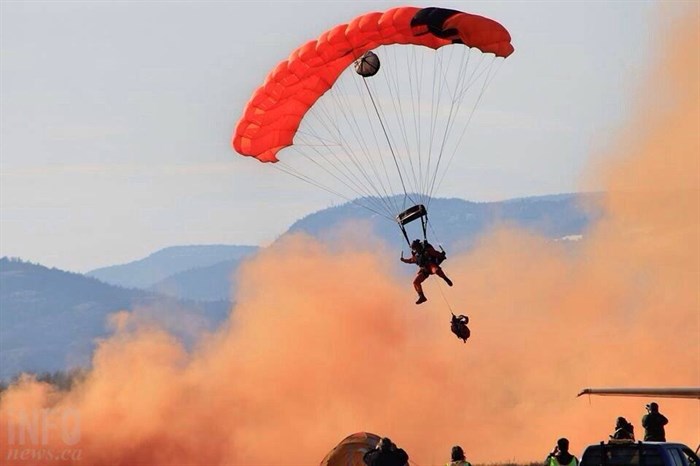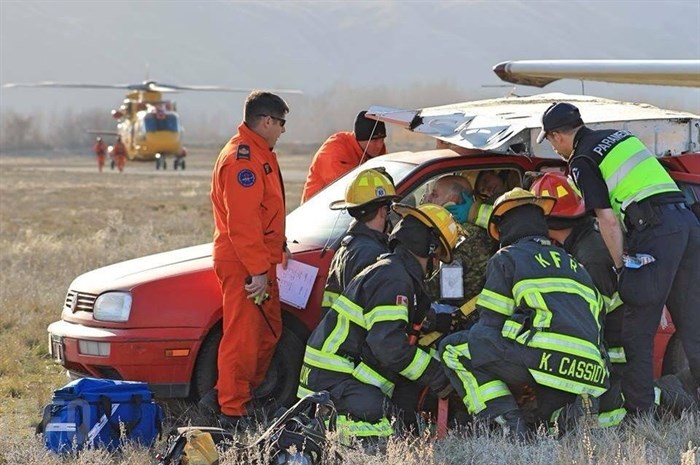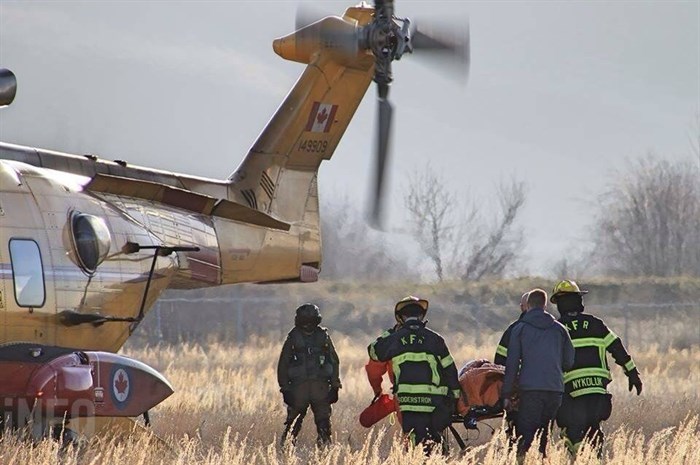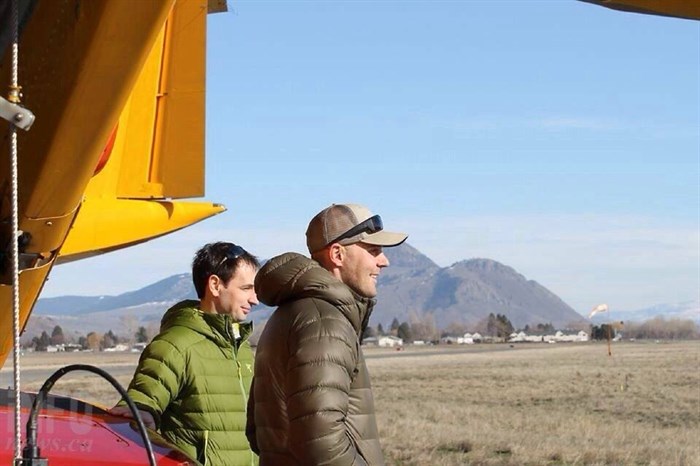
A Search and Rescue Technician from RCAF's 442 Squadron parachutes in to the mock emergency exercise scene to assist those injured and trapped in a makeshift plane collision at the Kamloops Airport.
(GLYNN BROTHEN / iNFOnews.ca)
February 26, 2016 - 1:00 PM
KAMLOOPS - Extinguishing fires, parachuting search and rescue technicians and the jaws of life were all part of a busy scene at the Kamloops airport yesterday, but the emergency was only an exercise, a unique one which gave local emergency crews a chance to work with the best of the best in search and rescue, the Royal Canadian Air Force’s 442 Transport and Rescue Squadron.
The Comox-based squadron descended upon the city for five days worth of exercises with Kamloops Search and Rescue, the Rocky Mountain Rangers, Kamloops Fire Rescue and local B.C. Ambulance Services which showed their preparedness for when disaster strikes.
“Every year we do a SAR exercise. It’s an annual event and we do it in different places across British Columbia. One of the main roles of this exercise is to have our crews deployed in a different area and have our crews train in different conditions, different weather elements. We also do this to get involved with other agencies,” RCAF Capt. Francois Fasquelle says. “Mainly our responsibility is aviation incidents, so if we have a plane crash, a lost aircraft, (or) someone injured on a vessel without a doubt that’s our primary responsibility. We will tag along on any other kind of rescues if help is required."
The aircraft — a CH-149 Cormorant helicopter and a CC115 Buffalo — are rigged up for just about any emergency and location, be it on land or sea. In each scenario, Fasquelle says both planes are typically deployed to make what’s impossible for local search and rescue possible. The Buffalo comes with two Search and Rescue technicians, paramedics clad in bright orange jump suits who do everything from parachute out of the plane with an extra 45-pounds worth of medical gear to assessing patients on site. Depending on the situation, that pack could even include a tent and week's worth of food.

A supervisor from RCAF's 442 Squadron watches on as local emergency crews work to help a Rocky Mountain Ranger with a fake neck injury. Crews pretended the car was the cockpit of an airplane involved in a airstrip collision.
(GLYNN BROTHEN / iNFOnews.ca)
"We do have very capable machines and have trained people to the highest level," he says.
The squadron is one of five in the country and is responsible for B.C., the Yukon territory and 250 nautical miles offshore on the Pacific Ocean.
"This is a great exercise for us; it’s good for us to cross train with the military," Kamloops Search and Rescue manager Alan Hobler says. "It’s rare that we can use these (resources) on a task but when we do they’re very indispensable."
The concluding exercise yesterday mimicked a two-plane collision on the runway at the Kamloops Airport. Two parachuting SAR techs, fires, medical emergencies and trapped survivors all created a panicked scene which called on local emergency staff to pair with 442 Squadron and transfer survivors to the Cormorant.
Amidst the chaos, senior military members serve as proctors. It's not a test, but the supervisor’s calm studious stance makes it feel like it is and juxtaposes with firefighters hustling to put out real fires and pull out the jaws of life to rescue a Rocky Mountain Ranger feigning a neck injury. Following the exercise, facilitators will present their feedback and share what worked or could use improvement.
It’s as realistic as can be without actual damage, injury or death. Despite that, two observers expressed a range of emotions on the field.
Christopher Eyre and Robert Austin credit the squadron members who pulled them from a heavily wooded area near Fort St. John last spring for saving their lives.
Both had killed a sheep that day and finished dressing it when they came upon a mother grizzly bear and her two cubs on the hike down.

After crews successfully pulled the injured man from the vehicle using the jaws of life, he's transported to the CH-149 Cormorant helicopter for medevac
(GLYNN BROTHEN / iNFOnews.ca)
“The bear mauled Chris quite badly and then it attacked me and it bit me on my neck which caused me to have a stroke and become paralyzed on my left side,” Austin says.
Eyre, a paramedic, fortunately equipped himself with a satellite phone that day which put them in contact with local authorities. Despite Eyre’s serious injuries, he quickly set to work to build a fire and stay protected.
"He looked like he was dying, but he leaned over me and checked me out, built me a fire, made sure our guns were ready and kept in contact with search and rescue," Austin says.
By the time a conservation officer and local Mounties found them, it was clear they would need extra help especially after local search and rescue couldn’t get their helicopters close enough to the area due to the thick timber.
It was a 10-hour wait, but 442 Squadron made it to the scene.
"It was overwhelming to feel like holy cow, you’re going to make it. It was a big deal,” Austin said holding back tears. "It’s a pretty tense situation; there’s a bear, we’re in rough shape and the one pilot was smiling and totally acting like he’s fine. It made you feel like you’re fine. These guys were super professional. There was no wasted movements. You could tell that this is their job and this is what they do."
Eyre and Austin made the trip to Kamloops to watch the exercise and meet their rescuers to thank them for saving their lives. Included in their gratitude, the pair raised over $33,000 which they donated to 442 Squadron last night.
"It's exciting and emotional at the same time," Eyre says.

Friends Christopher Eyre and Robert Austin were rescued by 442 after their hunting trip near Fort St. John turned disastrous. The pair were attacked by a mother grizzly bear and waited 10 hours to be saved. The pair credit their life to 442 whom they contacted through a satellite phone.
(GLYNN BROTHEN / iNFOnews.ca)
To contact a reporter for this story, email Glynn Brothen at gbrothen@infonews.ca or call 250-319-7494. To contact the editor, email mjones@infonews.ca or call 250-718-2724.
News from © iNFOnews, 2016